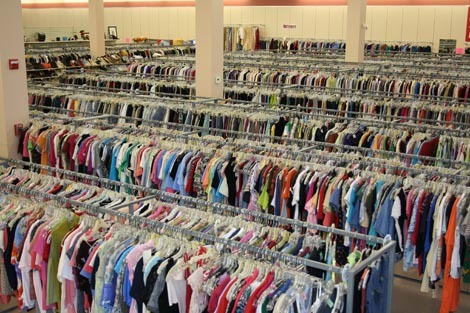Part Three: Getting the Good...: "

How to Thrift for Menswear
Part Three: Getting the Good Stuff
So: you’ve got your locations scouted and you’re repeating our thrifting philosophies in your head. What about picking the good stuff?
Thrift stores are full of high-quality menswear. Menswear is relatively timeless. Women shop for men, and they make mistakes - sometimes expensive ones. The kind of men who buy high-quality clothes don’t want to be bothered with selling them. The stuff is out there.
Here’s eight tips on how to pull in the cream of the crop:
- Know your fit. If you don’t try things on, you’re begging for a disaster. Learn what can be altered, then stick to stuff that will fit perfectly.
- Buy it when it’s there. Every thrift store piece is one in a million. Maybe more. Don’t put it back on the rack and go get lunch or even walk around the store thinking about it. If it’s right, buy it.
- Time your visits. Thrift stores keep regular schedules - new stock goes out at specific times. Either observe the patterns or simply ask politely when new stuff goes out. You can also try to hit sales, but at thrift store prices, getting something great is much more important than saving $5 or $8.
- Touch and stare. Perfect the thrift cruise. Run your hand across the shoulders of the garments while inspecting as carefully as you can. You’ll feel the good stuff as much as you’ll see it.
- Look for damage. Look carefully for damage. CAREFULLY. There’s nothing worse than losing $25 on a jacket with moth holes you missed, or a big stain. Hold pieces up to natural light to help spot holes, and check for stains - pants lining could be yellow (eww) or collars could be soiled. If you’re willing to put in the time and resources, you can fix these things (I’ve had pants linings replaced before), but factor that into your cost.
- Know your brands. Your goal should be to identify quality by sight and touch, but you can also cheat with a brand list. Of course, even pieces by fine brands can be sub-par, damaged or out-of-date, but it’s a start.
- Watch out for licensees & diffusion lines. If you find a piece by a well-known brand, but it’s not great quality, it’s probably a licensee or a diffusion line. Just as Ralph Lauren makes everything from Purple Label to J.C. Penney’s American Living, many brands offer goods at a variety of quality levels. Many fashion houses also sell or have sold their names to low-quality makers in their non-core businesses (like menswear). You can read our fuller piece about menswear licenses and thrifting, but suffice it to say: if the label says Yves Saint Laurent, Pierre Cardin, Givenchy, Lanvin or Christian Dior, it’s probably a piece of crap.
- eBay is your friend. If you’ve got a smart phone, you’ve got a way to identify the value of that piece in your hand. Search for completed auctions on the web or in the eBay app and get a sense of the market. Some brands fly under the eBay radar, but for larger brands, it’s an easy way to distinguish between Brioni (primo) and Baroni (junk).
One of the great pleasures of thrift store shopping is the opportunity to put your hands on all kinds of clothes - from the best to the worst. There are innumerable signs of quality, but here are a seven basic guidelines.
- Look for trousers with details that mean quality. Split waistbands, pick stitching in the fly, a belt loop, suspender buttons and a closure with a generous tab are good signs of a quality piece.
- Look for shirts with mother-of-pearl buttons. They’ll look more lustrous and feel cold on your lip. They’re more expensive and prone to chipping, so they’re only used on high-quality shirts.
- Look for fully canvassed jackets. Better jackets will have three discrete layers in their chest - an outer, a lining and a canvas in between. Use the pinch test to distinguish. If you only feel two, they canvas and outer are glued together, a sign of a lower-quality jacket.
- Don’t by corrected-grain shoes. Shoes that have a shiny, plasticky look are made of “corrected” or “polished” leather. Because of imperfections, they top layer is sanded off, then replaced with a plastic coating. This is cheaper than picking undamaged hides, so it’s most of what you’ll find on the thrift store shelf. They’re not worth your time or your $10.
- Never buy synthetics. I’ve been trying to think of a good reason to buy a piece of clothing with any synthetic fiber in it at all. All I can think of is a trench coat, which might have some synthetic for warding off rain. Otherwise, if you see polyester or nylon, put it back on the shelf.
- Don’t buy third-world-made goods. With the exception of basics that you need at that moment (say a perfectly fitting Brooks Brothers oxford - the classic thrift shirt), there’s no reason to buy clothes made in the third world. The words “Made in England” (or Italy or the US or Canada or Switzerland or Germany) don’t guarantee quality goods, but the words “Made in Bangalore” generally do guarantee something that’s mall-quality at best.
Of course, you’ll gain knowledge with experience, and you’ll make mistakes along the way, but I think you’re ready to get out there and shop!
Read the two other articles in our series: Thrifting Philosophy & Finding the Best Thrift Stores.
"
No comments:
Post a Comment